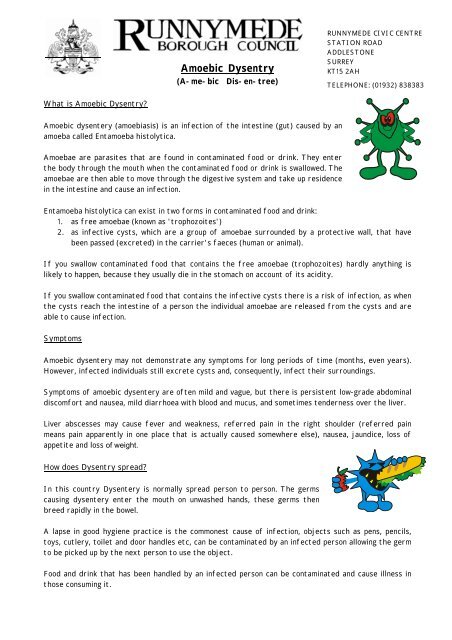Amoebic Dysentry
Amoebic Dysentry
Amoebic Dysentry
You also want an ePaper? Increase the reach of your titles
YUMPU automatically turns print PDFs into web optimized ePapers that Google loves.
<strong>Amoebic</strong> <strong>Dysentry</strong>RUNNYMEDE CIVIC CENTRESTATION ROADADDLESTONESURREYKT15 2AH(A-me-bic Dis-en-tree) TELEPHONE: (01932) 838383What is <strong>Amoebic</strong> <strong>Dysentry</strong>?<strong>Amoebic</strong> dysentery (amoebiasis) is an infection of the intestine (gut) caused by anamoeba called Entamoeba histolytica.Amoebae are parasites that are found in contaminated food or drink. They enterthe body through the mouth when the contaminated food or drink is swallowed. Theamoebae are then able to move through the digestive system and take up residencein the intestine and cause an infection.Entamoeba histolytica can exist in two forms in contaminated food and drink:1. as free amoebae (known as 'trophozoites')2. as infective cysts, which are a group of amoebae surrounded by a protective wall, that havebeen passed (excreted) in the carrier's faeces (human or animal).If you swallow contaminated food that contains the free amoebae (trophozoites) hardly anything islikely to happen, because they usually die in the stomach on account of its acidity.If you swallow contaminated food that contains the infective cysts there is a risk of infection, as whenthe cysts reach the intestine of a person the individual amoebae are released from the cysts and areable to cause infection.Symptoms<strong>Amoebic</strong> dysentery may not demonstrate any symptoms for long periods of time (months, even years).However, infected individuals still excrete cysts and, consequently, infect their surroundings.Symptoms of amoebic dysentery are often mild and vague, but there is persistent low-grade abdominaldiscomfort and nausea, mild diarrhoea with blood and mucus, and sometimes tenderness over the liver.Liver abscesses may cause fever and weakness, referred pain in the right shoulder (referred painmeans pain apparently in one place that is actually caused somewhere else), nausea, jaundice, loss ofappetite and loss of weight.How does <strong>Dysentry</strong> spread?In this country Dysentery is normally spread person to person. The germscausing dysentery enter the mouth on unwashed hands, these germs thenbreed rapidly in the bowel.A lapse in good hygiene practice is the commonest cause of infection, objects such as pens, pencils,toys, cutlery, toilet and door handles etc, can be contaminated by an infected person allowing the germto be picked up by the next person to use the object.Food and drink that has been handled by an infected person can be contaminated and cause illness inthose consuming it.
Prevention: Scrupulous personal hygiene including thorough handwashing. The use of liquid soaps and paper towels is advised if possible. What to do if you have someone ill or infected with food poisoning in the houseAnyone suffering from or carrying <strong>Dysentry</strong> SHOULD NOT prepare food for others to eat. We would recommend that you DO NOT have friends in for meals or to stay withyou whilst the infection is present.Whilst diarrhoea persists, great care should be taken to clean the toiletincluding taps, door and flush handles after the patient has used it.• Use a household disinfectant or bleach.• Use disposable paper tissues for cleaning seat, flushing handle etc.• Wash hands thoroughly afterwards, preferably with an antibacterial handwash soap.Hands should be washed thoroughly with hand soap and hot running waterfor at least ten seconds, to minimise the risk of cross-contamination.Cloth towels are not recommended for cleaning or drying as they getdirty quickly and can spread bacteria from one person to another,disposable tissues/towels are recommended.Other PrecautionsChildren should stay away from school until 48 hours after all symptoms have ceased. Furtheradvice in this case must be sought from the Environmental Services Department. The schoolshould be informed of the type of illness.Can I Still Work?People who work in food businesses, hospitals or nursery schools SHOULD NOT return to workuntil 48 hours after all symptoms have ceased. The manager of the food business should benotified of any illness you or any family member, who is ill, may have.If people are formally excluded from work, they will not normally be required to return to workuntil 48 hours after all symptoms have ceased.Please remember that you may still carry the organism for a number of weeks after the symptomsclear and scrupulous personal hygiene must be observed during this time.NOTE: THERE MAY BE TYPES OF FOOD POISONING WHICH WILL REQUIRE YOU TOREMAIN OFF WORK UNTIL CLEARANCE IS GIVEN BY YOUR ENVIRONMENTAL HEALTHOFFICER. YOU WILL BE ADVISED IF THIS IS THE CASE.For further information, contact your local Environmental Protection Division, telephone number01932 838383, or in case of continuing illness, consult your family doctor.
















